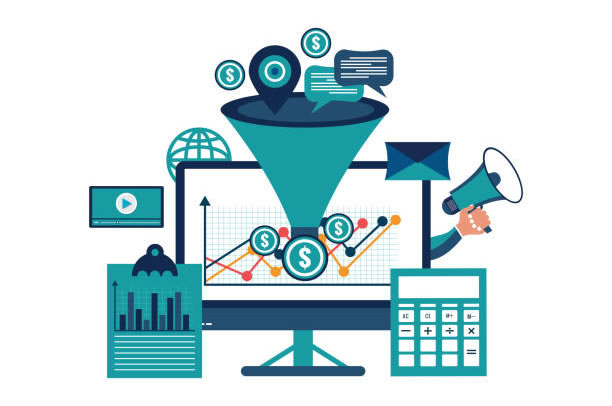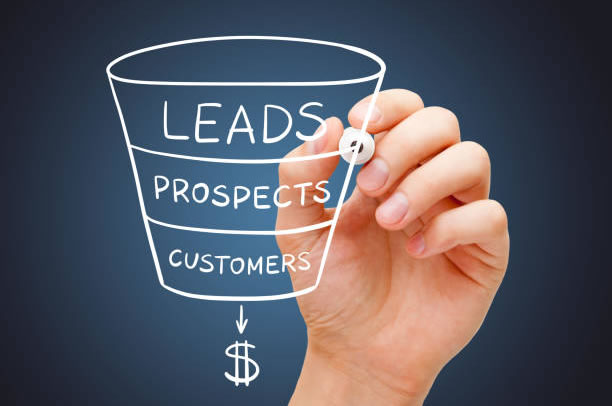The Role of Email Marketing in Sales Funnels
Introduction
Email marketing in sales funnels in today’s digital landscape has evolved from being a mere communication tool to a strategic asset for businesses. Email marketing can significantly influence the customer journey and play a crucial role at every stage of the sales funnel.
This guide will explore how email marketing, when integrated effectively, can help you attract, engage, and convert leads into loyal customers, ultimately driving revenue.
Understanding the Sales Funnel

Before we dive into the intricacies of email marketing, it’s vital to comprehend the sales funnel and its role in the customer acquisition process. The sales funnel is a representation of a potential customer’s journey, from the initial awareness stage to making a purchase decision. It typically consists of three main stages:
Top-of-Funnel (TOFU): Attracting Prospects
The top of the funnel is where you create brand awareness and generate interest among potential customers. It’s the stage where email marketing can introduce your brand to a broader audience and spark initial curiosity.
To maximize the impact at this stage, create captivating content that resonates with your target audience. Utilize email marketing to send out newsletters, informational content, and engaging stories that encourage recipients to take the first step in their customer journey.
Personalized Outreach for a Lasting Impression
One of the most effective strategies at the top of the funnel is personalized outreach. Addressing recipients by their names and sending tailored content can make a lasting impression. Personalization not only grabs the recipient’s attention but also lays the foundation for building a strong relationship with potential customers.
Middle-of-Funnel (MOFU): Building Interest
In the middle of the funnel, prospects have shown interest in your brand, but they’re not ready to make a purchase yet. This stage is about building a deeper connection and nurturing the relationship with your leads. Email marketing here is invaluable for maintaining engagement and guiding your leads toward conversion.
Segmenting Your Email List
Segmenting your email list into smaller, more targeted groups can significantly enhance your MOFU email marketing efforts. By delivering content that caters to the specific needs and interests of each segment, you can keep your leads engaged and gradually push them closer to the bottom of the funnel.
Bottom-of-Funnel (BOFU): Converting Leads
The bottom of the funnel is where the prospects are ready to make a purchase decision. This is where the rubber meets the road, and email marketing can be a game-changer in convincing leads to become paying customers.
Crafting Persuasive Email Copy
At this stage, the language and content of your emails need to be more persuasive and focused on conversion. Use compelling calls to action (CTAs) to encourage recipients to take the desired action, whether it’s making a purchase or scheduling a consultation.
Reducing Abandonment with Retargeting
Email marketing can also help reduce shopping cart abandonment. If a potential customer added items to their cart but didn’t complete the purchase, sending a well-timed email with a reminder and an enticing offer can rekindle their interest and lead to a conversion.
Post-Purchase Email Sequences
The customer journey doesn’t end once a sale is made. In fact, it’s just the beginning. Post-purchase email sequences play a crucial role in nurturing long-term relationships with customers and encouraging repeat business.
Building Customer Loyalty
Send post-purchase emails that express your gratitude and provide value to your customers. Offer helpful resources, tips, and advice related to their purchase. This not only builds loyalty but also positions your brand as a trusted source of expertise.
Upselling and Cross-Selling
Email marketing can also be used to upsell and cross-sell additional products or services to existing customers. Craft targeted email campaigns that showcase complementary products or exclusive offers, increasing the customer’s lifetime value.
Seeking Reviews and Testimonials
Customer reviews and testimonials are powerful tools for building trust with potential customers. Use email to request feedback and encourage satisfied customers to leave reviews. Share these reviews on your website and in future email marketing campaigns to boost credibility.
Measuring Email Marketing Performance
To gauge the effectiveness of your email marketing efforts, it’s essential to employ analytics and track key metrics. Understanding how your emails are performing enables you to make data-driven decisions and continually optimize your strategies.
Utilizing Analytics
Leverage analytics tools to monitor email open rates, click-through rates, conversion rates, and other relevant metrics. This data will help you understand which email campaigns are working and which need improvement.
Data-Driven Optimization
Use the insights gathered from your analytics to fine-tune your email marketing strategies. Experiment with different subject lines, content types, and sending times to see what resonates best with your audience.
Integration with Other Marketing Channels
Email marketing should not exist in silos. It can enhance its impact by seamlessly integrating with other marketing channels. Coordinated marketing efforts across multiple channels can create a unified and compelling customer experience.
Multichannel Marketing Campaigns
Incorporate email marketing into your broader marketing strategy, encompassing social media, content marketing, and paid advertising. Consistent messaging across various channels reinforces your brand and messaging.
Reaching Customers Where They Are
Understanding your audience and knowing their preferred communication channels is key. Some customers may respond better to email, while others may prefer social media or SMS. Adapt your multichannel approach to reach your customers where they are most responsive.
Building a Successful Email Marketing Strategy
To maximize the impact of email marketing on your sales funnel, you need a well-thought-out strategy. This strategy should encompass various elements, including content creation, list management, and automation.
Holistic Email Marketing Strategy
Your email marketing strategy should be holistic, covering all stages of the funnel. It should align with your broader marketing and business goals and be consistently updated and improved.
Key Elements for Successful Email Campaigns
Ensure your email campaigns include elements such as compelling subject lines, relevant content, clear CTAs, and mobile optimization. These elements make your emails more engaging and effective.
Common Mistakes to Avoid
Avoid common pitfalls in email marketing, such as over-emailing your subscribers, neglecting mobile responsiveness, or sending irrelevant content. These mistakes can harm your reputation and lead to unsubscribers.
Conclusion
Email marketing has transcended the role of a mere communication tool and become a potent weapon in the arsenal of businesses seeking to enhance their sales funnels. From attracting prospects at the top of the funnel to converting leads at the bottom and nurturing long-term customer relationships, email marketing plays a multifaceted role in the modern marketing landscape. By implementing the strategies outlined in this guide, you can elevate your conversions and drive sustained revenue growth.
FAQs:
Q1: How often should I send emails to my subscribers?
A1: The frequency of your emails depends on your audience and the nature of your business. It’s essential to strike a balance between staying top-of-mind and avoiding overwhelming your subscribers. Test different frequencies and monitor open rates and unsubscribes to find the optimal sending schedule.
Q2: Can I use email marketing for B2B sales funnels?
A2: Absolutely. Email marketing is highly effective for B2B sales funnels. You can use it to nurture leads, share industry insights, and build relationships with potential clients. Segment your email list and create content tailored to the specific needs and pain points of your B2B audience.
Q3: What are the best email marketing platforms to use?
A3: Several email marketing platforms are popular and widely used, such as MailChimp, Constant Contact, and HubSpot. The choice of platform should align with your business’s needs, budget, and features. Consider factors like automation capabilities, list management, and reporting when making your selection.
Q4: How can I ensure my emails are mobile-friendly?
A4: To ensure your emails are mobile-friendly, use responsive email templates that adapt to various screen sizes. Keep your subject lines concise and legible on mobile devices, and use a single-column layout for readability. Test your emails on different mobile devices and email clients to identify and fix any formatting issues.
Q5: What’s the best way to build an email list for my business?
A5: Building a high-quality email list is essential. You can start by offering valuable content, such as ebooks, webinars, or exclusive discounts, in exchange for email subscriptions. Additionally, utilize social media and website sign-up forms to capture potential leads. Always obtain consent and ensure your list complies with relevant privacy regulations.
As you integrate email marketing into your sales funnel, remember that it’s a dynamic field. Stay updated with the latest trends and continuously refine your strategies to adapt to changing customer behaviors and market conditions. By doing so, you can leverage email marketing to its full potential and maximize your conversions in today’s competitive business environment.




Leave a Reply
Want to join the discussion?Feel free to contribute!